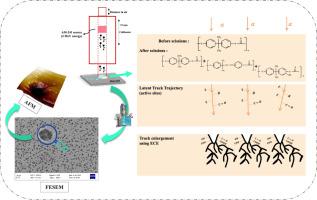Alpha particle fluence-dependent physico-chemical properties of polycarbonate (Makrofol) surface after electrochemical etching
IF 6.3
2区 材料科学
Q2 CHEMISTRY, PHYSICAL
引用次数: 0
Abstract
The optical properties of polycarbonate (Makrofol) samples are investigated under alpha irradiation with 2 MeV energy at various fluences ranging from of 103 to 106 alpha/cm2, following the electrochemical etching (ECE). Several microanalyses are carried out to characterize the optical, chemical, and structural properties of the samples, including field emission scanning electron microscopy (FESEM), UV-visible absorption spectroscopy, Photoluminescence (PL) spectroscopy, and BET analysis. Surface features and functionalities are further assessed by X-ray photoelectron spectroscopy (XPS) and attenuated total reflectance/Fourier transform infrared (ATR-FTIR) spectroscopy. Additionally, surface wettability is examined through contact angle measurements. Image processing of micrographs obtained from FESEM is utilized to determine track density, induced micro-hole diameter, and corresponding depth. Finally, machine learning (ML) is employed to accurately predict unknown patterns induced by the combined alpha irradiation and ECE. Specifically, k-nearest neighbors (KNN) classification with Bayesian optimization is used to identify alpha fluence levels with 90.1 % accuracy.

电化学刻蚀后聚碳酸酯(Makrofol)表面α粒子影响的物理化学性质
研究了聚碳酸酯(Makrofol)样品在电化学蚀刻(ECE)后,以2 MeV能量在103 - 106 alpha/cm2的不同影响下辐照的光学性质。进行了几种微观分析来表征样品的光学,化学和结构特性,包括场发射扫描电子显微镜(FESEM),紫外-可见吸收光谱,光致发光(PL)光谱和BET分析。通过x射线光电子能谱(XPS)和衰减全反射/傅立叶变换红外(ATR-FTIR)光谱进一步评估表面特征和功能。此外,通过接触角测量来检查表面润湿性。利用FESEM获得的显微照片进行图像处理,确定轨迹密度、诱导微孔直径和相应的深度。最后,使用机器学习(ML)来准确预测α照射和ECE联合诱导的未知模式。具体来说,使用贝叶斯优化的k近邻(KNN)分类来识别alpha影响水平,准确率为90.1 %。
本文章由计算机程序翻译,如有差异,请以英文原文为准。
求助全文
约1分钟内获得全文
求助全文
来源期刊

Surfaces and Interfaces
Chemistry-General Chemistry
CiteScore
8.50
自引率
6.50%
发文量
753
审稿时长
35 days
期刊介绍:
The aim of the journal is to provide a respectful outlet for ''sound science'' papers in all research areas on surfaces and interfaces. We define sound science papers as papers that describe new and well-executed research, but that do not necessarily provide brand new insights or are merely a description of research results.
Surfaces and Interfaces publishes research papers in all fields of surface science which may not always find the right home on first submission to our Elsevier sister journals (Applied Surface, Surface and Coatings Technology, Thin Solid Films)
 求助内容:
求助内容: 应助结果提醒方式:
应助结果提醒方式:


